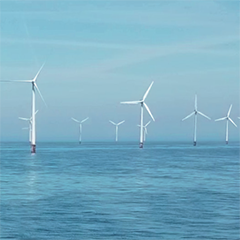The daughter craft for wind farms far from shore
Over the last three years we have seen the introduction of purpose-built Service Offshore Vessels (SOV). These 70-100 m long vessels service wind farms, where a long distance to shore makes a land-based service organization impractical. Typically, 40-60 technicians live onboard the vessels and are transferred to the wind turbines with motion compensated walk-to-work gangways. A challenge for this operation is the efficiency of getting the technicians around the wind farm. The SOV transits at typically 10 knots and needs time for accurate positioning, to set out and also collect the personnel.
This is the background for using daughter craft. Deployed and retrieved by a davit system onboard the SOV, she can complement the gangway, shuttle between the SOV and turbines near and far throughout the wind farm. So far these daughter craft have been of similar type to existing small rescue crafts. Monohull, 10-12 m in length and weight 8-15 tons. But these small vessels can transfer to the turbines in limited wave height, typically up to 1 to 1.2 m significant wave height and will therefore get limited weather windows. An alternative is to use larger Crew Transfer Vessels (CTV) of 25-30 meter length that can stay 24/7 in the wind farm, however, with significantly increased cost, due to larger vessels with more manning and the need for transfer to the shore far away.
A daughter craft needs to be lightweight and small to operate from an SOV. But at the same time she should be able to operate in a large weather window. An offshore wind trend is that near-shore CTVs are getting larger. Many of the first CTVs were catamarans of 15-16 meter length, while now most newbuilds are 20-28 meter length. The most evident reason for this is the required increased operational weather window with increased operational wave height. This is illustrated in the following figure.
Using the mentioned wind farms as an example, this table shows typical weather windows for different operational wave heights.






























